|
Cableship Stamps - D to G |
| Thanks
to Bill Glover for providing the stamp images and text for this page.
All material on this page is copyright © 2005 Bill Glover
except as noted |
|


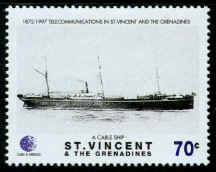
|
DACIA
Jamaica 1970 3c &10c
St Vincent <1997 <70c
Built
1867, J. Laing & Company, Sunderland
Length
283.00 ft Breadth 34.7 ft Depth 17.9 ft Gross
tonnage 1856.
Purchased from Norwood & Co in 1870 by Charles
Tilston Bright and converted for use as a cable ship. This included
cutting the ship in two and inserting a 40 foot section. Bright then
sold her to the India Rubber, Gutta Percha & Telegraph Works Company.
Remained in service as a cable ship until 1915 when torpedoed off
Funchal while diverting a German cable, into Brest, for the French
CABLE
WORK
1870 Batabano - Cienfuegos - Santiago
da Cuba (Cuba) - Kingston
1871 San Juan, Puerto Rica - St
Thomas - St Kitts - Antigua - Guadeloupe -
Dominica - Martinique - St Lucia - St Vincent - Barbados - Grenada
- Trinidad - British Guiana
Marseilles - Algiers
1872 Kingston - San Juan
England - Spain
1873 Kingston - Colon, Panama
1874 France - Spain
1875 Chile - Peru
1879 Marseilles - Algiers
1880 Marseilles - Algiers
1881 Galveston - Vera Cruz
1882 Galveston, Texas - Coatzacoalcos
- Vera Cruz, Mexico
1883 Dakar - Tenerife, Canaries
Cadiz, Spain - Las Palmas, Canaries
Confital - Regla, Canaries
Garachio - Santa Cruz la Palma, Canaries
1885 Bathurst - St Jago - Cape
St Vincent - St Louis - Dakar
Bathurst - Boloma - Bissau - Konakry - Freetown
- Bassam - Accra - Cotonou - St Thomas - Principe
- Libreville - Luanda
1915 Diverted German South America
cable to Brest
|
|

LADY DENISON PENDER
St Helena
1995 5p
Built 1920, Fairfield Ship Building and Engineering Co., Glasgow
Length 269.2 ft Breadth 38.1 ft Depth 23.8 ft Gross tonnage 1984
Built for the Eastern Telegraph Company as a repair ship and fitted
out by the Telegraph Construction and Maintenance Company and based
at Aden. Transferred in 1929 to Imperial and International Communications
Ltd. During WW2 she was crewed by men from St Helena and spent most
of the war in the Atlantic. After the war she returned to Aden and
later transferred to the West Indies where she remained until withdrawn
from service in 1963 and scrapped.
|
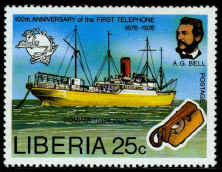
DOMINIA
Liberia
1983 25c
Built 1926, Swan, Hunter & Wigham Richardson Ltd
Length 488.9 ft Breadth 59.0 ft Depth 37.4 ft Gross tonnage 9273
Built for the Telegraph Construction & Maintenance Company specifically
to lay the loaded cable from Canada to Fanning Island for the Pacific
Cable Board. On the merger with Siemens Bros in 1935 only one cable
ship was needed so DOMINIA was sold to the Russian government in 1937and
renamed NICKOLAI EJOV.
CABLE WORK
1926 Bamfield, British Colombia
- Fanning Island
1929 Algericas - Ceuta
Tenerife - Gran Canaria
Vigo - Carcavelos
1930 Willemstad - La Guayra
Willemstad - Aruba
Aruba - Maracaibo
Maracaibo - Barraquilla
Belgium - Portugal
|
|
More
on DOMINIA

DOMINIA as the
FELIX DZERZHINSKY, tied up in San Francisco Harbor
Marty Bollinger has written
a book on Stalin's Slave Ships and adds this interesting note on what happened
to Dominia after she was sold to the Russian Government. If
you have any further information on this ship, please email Marty directly.
The Dominia was sold to
the Soviet Union as you report, with the handover taking place in
Amsterdam on 1 January 1937. But the story gets more interesting.
The USSR was represented
personally at the handover by Eduard Berzin, the Soviet authority
who had arranged its purchase. Berzin was not just any Soviet manager
-- he was the founder and director of the powerful Dal'stroi organization,
responsible for the operation of the infamous Kolyma Gulag system
in eastern Siberia, in some of the coldest and remote parts of the
world. Ultimately a million or more prisoners served in these slave
labor camps and hundreds of thousands died.
The Dominia was purchased
to serve as the flagship of a specialized fleet of prisoner transports,
taking slave laborers from Vladivostok to Magadan. The ship was initially
named Nikolai Yezhov, after the head of the NKVD (KGB). Yezhov was
promptly arrested and shot, so the ship was renamed after a already-dead
leader of the NKVD, Felix Dzerzhinsky.
The Felix Dzerzhinsky served
in the Dal'stroi Gulag fleet for several decades and likely took a
hundred thousand or more prisoners to the slave labor camps. During
World War II it was deployed on Lend Lease duties across the Pacific
and entered U.S. port numerous times. (I have photos of the ship at
sea off the Oregon coast and in San Francisco harbor in 1942 and 1944.
It was extensively upgraded and overhauled in the U.S. during the
war.)
The Felix Dzerzhinsky was
returned to Gulag service after the war and is one of the ships mentioned
in recent joint Russia/US investigations into America POW/MIAs: there
are witnesses who claim the Felix Dzerzhinsky took U.S. military personal
-- imprisoned by the Soviets -- into the Gulag camps in Kolyma. The
ship is also confirmed to have picked up ex Russian POWs from Germany
from the US and then promptly deposited them in the labor camps. The
U.S. authorities had believed the Soviets authorities were going to
repatriate their freed POWs.
The final disposition of
the ship is unclear, but it was removed from the Russian Maritime
Register of Shipping in 1978. It may have been scrapped as early as
1968.
Text and image in this
section copyright ©
2006 Marty Bollinger
|
|

WYATT EARP
Falkland Islands Deps
1954 1½d
Built 1919 in Norway
Length 150.00 ft Breadth ? Depth ? Gross tonnage 350
Built originally as a fishing boat named FANEFJORD. Used for fishing and
sealing. Purchased by Sir Hubert Wilkins for Lincoln Ellsworth who renamed
her WYATT EARP. Used by him for Antarctic exploration. Sold to the Australian
government and renamed WONGALA. Wrecked about 150 miles north of Brisbane
on 25 January 1959
CABLE WORK
194? Defence cables around Darwin during
WW2
|
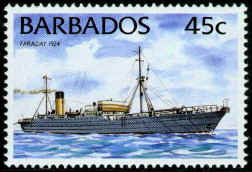
FARADAY (2)
Barbados
1994 45c
Built 1923, Palmers Ship Building Company Limited, Newcastle on Tyne
Length 394.3 ft Breadth 48.3 ft Depth 34.6 ft Gross tonnage 5533
Owned by Siemens Brothers and retained by them when they joined with
the Telegraph Construction and Maintenance Company to form Submarine
Cables Ltd. The ship then being chartered to the new company. At the
onset of WW2 in 1939 Faraday was laid up at Falmouth until December
when she was chartered by the Admiralty to recover 265 nm of German
cable lying between the Varne Bank and Ushant. It was successfully
recovered and unloaded at Greenwich for reconditioning. The idea was
to use the cable to link the UK to Narvik where British troops had
landed but the subsequent evacuation stopped this. With nothing to
do the ship was moved to the River Dart and laid up. Shortly after
this move she was requisitioned by the Admiralty and renamed HMS Faraday
the idea being to use her as a training ship. Once again she was chartered
for a cable expedition and the cable was brought to her by two small
coasters. Leaving Falmouth on the 25 March 1941 for Milford Haven
in convoy with five other ships which became scattered because of
poor visibility, Faraday came under attack at about 7.45 pm from a
Heinkel 111 which dropped two bombs and strafed the ship with machine
gun fire killing eight of the crew and injuring twenty five. The bombs
exploded in the oil bunkers causing a serious fire and the crew abandoned
ship, which finally sank off St Anne's Head. The Heinkel was shot
down by Faraday's gunners.
CABLE WORK
1923 UK - USA New York - Canso
section
1924 Barbados - Demerara
Barbados - Trinidad
Barbados - Turks Island
Aldeburgh - Domburg 1 (Telephone cable)
Cape St Vincent - Fernando Noronha (Brazil)
1926 Pacific Cable Fanning Island
- Fiji section
Balboa - Santa Elena
Dumpton Gap - La Panne 1 (Telephone cable)
1929 Ballyhornan - Isle of Man 1
Ballyhornan - Isle of Man 2
Blackpool - Port Greenhaugh
1930 Dumpton Gap - La Panne 2 (Telephone
cable)
1932 St Margarets Bay - La Panne
5 (Telephone cable)
1935 Australia - Tasmania (Telephone
cable)
1937 UK - Holland (Two telephone
cables)
UK - Ireland (Two telephone cables)
Aber Geirch - Howth (Two telephone cables)
Aldeburgh - Domburg 4 & 5 (Telephone cables)
Port Kale - Donaghadee 4 & 5 (Telephone cables)
Aber Geirch - Howth 2
1938 UK - Guernsey - Jersey (Telephone
cable)
Jersey - Pirou 2 (Telephone cable)
Aber Geirch - Howth 3
Tunis - Beirut
Nabeul - Beirut
|
|
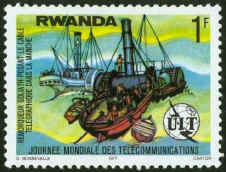
GOLIATH
Rwanda 1977
1f
Built ?
Length ? Breadth ? Depth ? Gross tonnage ?
First ever commercial cable
ship. Laid the first Cross Channel cable in 1850 for the Submarine Telegraph
Company.
The ship's name is given as
Goliah in some accounts. See the main page on Goliath for further information.
CABLE WORK
1850 Dover - Cap Gris Nez
See
Bill Glover's article on Goliath's work for the Submarine Telegraph
Company
|
|
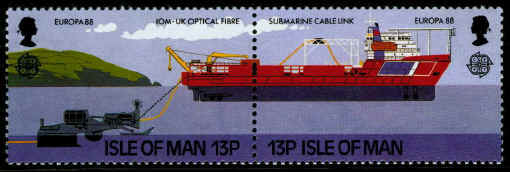
FLEXSERVICE 3
Isle of Man
1988 13p 381-2
nk 367-8 nk
Built 1982, Fosen Mek. Versted, Norway
Length 103.1m Breadth 19.4m Depth 6.6m Gross tonnage 5662
Owned by Northern Contractors International Ltd and operated by Cable
& Wireless as a cable layer. Underwent a major refit in 1992 which
included lengthening her by 13m. Sold to Sino British Submarine Systems
in 1995 and renamed FU LAI. Based at Shanghai for cable maintenance
in the area. Operated by Global Marine Ltd.
CABLE WORK
1987 UK - Isle of Man
UK - Holland 12
1992 TAT 11
1995 China - Korea
|
|
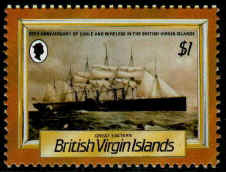


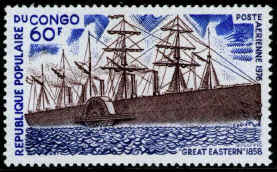


|
GREAT EASTERN
Bhutan
1989 3n
British Virgin Islands 1986 $1,
$1.50
Canada
1987 36c
Congo Republic 1976 20f, 60f
Great Britain 1987
22p
Monaco 1955
2f
Monaco 1965
95c
Portugal 1970
1-2e50
Built 1853, John Scott Russell, Milwall (London)
Length 697.6 ft Breadth 82.8 ft Depth 63.0 ft Gross tonnage 18914
Built for the Australian run but never used in that capacity. Sailed
the Atlantic as a passenger ship but was not successful. Purchased
by Daniel Gooch in 1864 and offered to the Atlantic Telegraph Company
to lay their cable. Ended her days as an advertising hoarding for
Lewis's department store. Breaking up began on 1 January 1889 and
it took two years to finish the task.
CABLE WORK
1865 Ireland - Newfoundland
(Failed, recovered and completed in 1866)
1866 Ireland - Newfoundland
1869 France - USA
1870 India - Aden (Part of Indo
European cable)
1873 Ireland - USA
1874 Ireland - USA
The two Portuguese stamps depict Great Eastern laying the Portugal
- England section of the Indo European cable. CS HIBERNIA laid this
section.


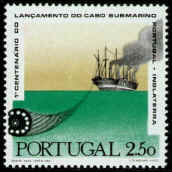
|
Research Material Needed
The Atlantic Cable website is non-commercial,
and its mission is to make available on line
as much information as possible.
You can help - if you have cable material,
old or new, please contact me. Cable samples, instruments, documents,
brochures, souvenir books, photographs,
family stories, all are valuable to
researchers and historians.
If you have any cable-related items
that you could photograph, copy,
scan, loan,
or sell, please email me: [email protected]
—Bill Burns, publisher and webmaster: Atlantic-Cable.com |
|

